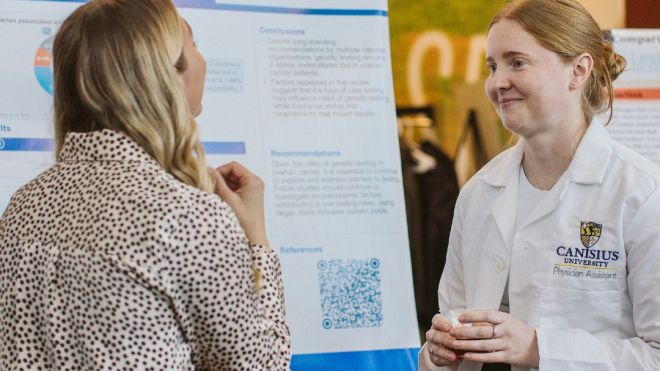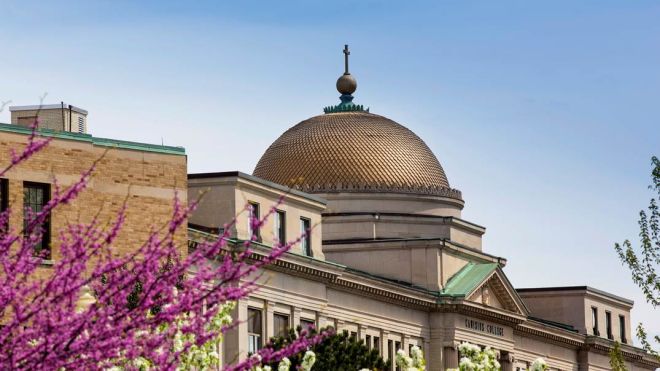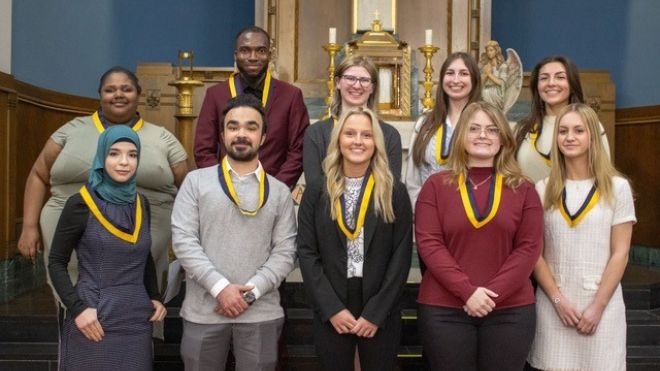Accounting major Kimberly M. Nowicki ’14 stepped outside of her comfort zone during an assignment for the course Religious Diversity in Buffalo, taught by Jonathan D. Lawrence, PhD, associate professor of religious studies and theology. Raised in a Roman Catholic family, Nowicki visited a church unfamiliar to her.
“The service was very joyful and interactive, even during the sermon. There was so much singing,” says Nowicki, of her visit to Spirit of Truth Urban Ministry in Buffalo’s Lovejoy neighborhood. Spirit of Truth is a non-denominational church, which does not recognize many of the aspects that make the Catholic Church distinctly Catholic, such as formal hierarchy, the Sacraments and the Eucharist. Both houses of worship, however, represent places where life is found, repentance is sought and acceptance is given. “It was enriching and the worshippers welcomed us with open arms.”
Religious Diversity in Buffalo requires Canisius students to go beyond the classroom to explore Buffalo’s vibrant religious community. The course helps students to investigate the various religious beliefs in Buffalo but also illustrates the common threads that tie them together. Oftentimes, students are encouraged to reflect on their own faiths.
“Students are interested in learning more about other religious communities but are often uncomfortable visiting houses of worship or unsure about how to find reliable information about different religions,” says Lawrence, who is also an ordained American Baptist minister and a pastor. “This project provides a comfortable environment for students, their families and community members to share stories about their religious traditions and beliefs.”
Royshawn M. Sessum ’12, ’13 interviewed his aunt, a Baptist. “She has such a strong faith. I wanted to know what influenced that,” says the accounting/accounting information systems graduate. Sessum learned that Baptists regard the Bible as God’s divine instruction. “My aunt explained to me that the Bible serves as her GPS in life.”
Students videotape their interviews with members of different religious denominations or the church services they attend. Edited projects are screened at an event open to the campus and greater Buffalo community.
“The students do a great job of capturing both the practice of different traditions and feelings of people about their community of faith,” says M. Bruce McKay, pastor of Pilgrim St. Luke’s United Church of Christ. “Our community is becoming increasingly religiously diverse. Unless we experience the practice of religious traditions other than our own, we can’t expect to fully understand them.”
In the past 50 years, immigration has dramatically changed the religious landscape of the United States. Western New York is no exception, says Lawrence. “The Buffalo area is comprised primarily of Roman Catholics however most major religions are now represented.”
The 2010 U.S. Religion Census, conducted by the Association of Statisticians and Religious Bodies, shows significant declines in Catholic, Protestant, Jewish and some evangelical denominations in the last decade. At the same time, the local Muslim community is now estimated at more than 18,000 people in Erie and Niagara counties; triple that from just 10 years ago. “The single most important belief in Islam is the oneness of God (Allah),” says Lawrence. He explains that Muslims serve Allah through daily prayer and charitable giving. They fast during the month of Ramadan to express their gratitude to Allah, to atone for past sins and to remain mindful of the needy.
Buddhism is also an increasingly practiced religion in Buffalo. The belief system emphasizes leading a moral life, mindfulness of thoughts and actions, and the development of wisdom and understanding. It is practiced primarily by Buffalo’s Burmese refugee population, which now makes up one percent of the city’s ethnic groups.
The results of the census underscore the tremendous scope of ethnic change at home and across the country. It says little, however, about its religious significance.
Lawrence is helping to change that.
His course is part of a personal research project entitled “Religion in Western New York.” The study maps the diversity of religious communities throughout the region to examine how religious traditions and interactions in Buffalo compare with those in other American cities.
Lawrence shares his findings with The Pluralism Project at Harvard University, a national initiative that examines the impact of religious diversity in civic life and explores new forms of interfaith engagement.
“I hope to discover more examples of how religion in Buffalo is changing – not gone and unimportant – just changing,” says Lawrence.
A unique spot on Buffalo’s evolving religious map is the Hindu Cultural Center in Amherst, NY, where Allison V. Buethe ’12 chose to visit.
“The woman who manages the temple gave us a very informative presentation about the foundation of Hindu beliefs and how the denomination is involved in the local community,” says Buethe.
She recalls that unlike most other religions, Hindusim has no single founder, no single scripture and no commonly agreed set of teachings. Rather it draws upon a common system of values known as dharma: the power that gives humans the opportunity to act virtuously. Dharma is understood to be service to humanity and to God.
“Diversity and awareness of diversity can lead to understanding and cooperation. Buffalo is a good example of where people are managing to get along,” says Lawrence, who is also president of the Network of Religious Communities. The Network fosters interreligious and ecumenical dialogue and cooperation between denominations, congregations and organizations.
Much like Lawrence does in his class.
“Someone asked why certain religions wear headpieces, and he built an entire class lecture and discussion around that question,” says Matthew A. Skok ’13, a graduate of the management program. “There isn’t a traditional syllabus for this class. Dr. Lawrence told us ‘You are here to learn about yourself and your community.’ It’s very experiential.”
One of the experiences includes a tour of Forest Lawn Cemetery.
“We learned that there are different traditions for different faiths,” adds Skok. “For instance, people in the Jewish faith place a rock on the headstone each time they visit their loved ones at the cemetery out of respect.”
Students also dine with the Sisters of St. Mary of Namur, who share the history of the order and its mission to serve those most in need.
“The students are able to see the sisters for the approachable, beautiful people that they are,” says Sister Patricia Brady, SSMN, director of Canisius' community-based learning. “We are people like everyone else but people with a mission.”
“It was great to speak with them, learn why they decided to enter the sisterhood, and what their lifestyle is like,” says Buethe.
Kimberly Nowicki’s spiritual journey remains a “work in progress.”
Although she does not actively practice any one religion, Religious Diversity in Buffalo gave her a greater understanding of her faith and that of others.
“To have a class take you on a personal journey is rare,” she notes. “It definitely helped me step back and see the common threads between all religions. Perhaps it is possible to identify with different aspects of different religions.”
WEB EXTRA: Click here to view "Voices of Justice," a compliation of student interviews conducted for the course Religious Diversity in Buffalo.



